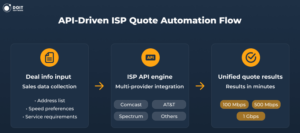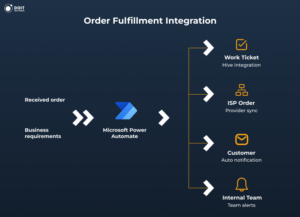The telecom industry operates on razor-thin margins where speed and accuracy determine competitive advantage. When you’re an internet wholesaler serving large business clients with dozens of locations, manual quoting processes can become your biggest operational bottleneck. Each delayed quote represents lost revenue, and every pricing error can damage long-term client relationships.
In this case study, you’ll discover how automation developers transformed a similar time-intensive manual workflow into an automated quoting system. Keep reading to learn how the right ISP automation strategy can compress days of work into minutes.
The Internet connectivity wholesaler operates in a specialized niche within the telecommunications sector. They aggregate broadband services from major ISPs, such as Comcast, AT&T, and Spectrum, and then present unified quotes and consolidated billing to enterprise clients.
Their typical customers include restaurant chains and hotel groups, businesses that need reliable internet access across multiple locations. These clients often require identical service levels at 30+ locations scattered across different service territories.
The company aims to simplify connectivity procurement for businesses that would otherwise need to negotiate separately with each ISP in every market.
However, their manual telecom quote management process created significant operational friction. Each customer inquiry triggered a complex workflow that involved:
The result was a quoting process that took multiple days for large accounts. This delay meant losing prospects to competitors who could respond faster. Moreover, the manual approach limited the company’s ability to handle increased quote volume as it grew.
Process automation specialists approached this challenge by building a comprehensive platform that streamlined every aspect of the pricing workflow. The solution focused on two components: intelligent quote automation and backend order integration. Let’s take a further look!
The foundation of the automated quoting solution started with creating a streamlined input interface that captured all necessary deal parameters in a single session.

Automation engineers built a platform that replaced the manual ISP coordination process. The simple interface allowed sales teams to input three key elements:
Then, technical specialists connected this interface directly to ISP APIs from Comcast, AT&T, Spectrum, and other major providers.
When sales teams submitted requests, the system queried all relevant ISPs simultaneously and returned unified pricing options within minutes.
At this point, sales representatives no longer needed to maintain relationships with multiple ISP contact points. The automated quoting software eliminated human error in data transfer and ensured consistent formatting across all provider responses.
The second phase focused on order fulfillment workflows. The automation experts recognized that efficient quoting loses its value if the team still relies on manual order processing.
For this purpose, the specialists chose to connect Microsoft Power Automate to monitor order status. This platform integrates seamlessly with the client’s existing systems and eliminates the manual coordination that previously caused delays.

The Microsoft Power Automate integration provided operations teams with real-time visibility into the entire order pipeline. At this stage, they no longer needed the manual status meetings and follow-up calls that had consumed a significant amount of the team’s time.
All in all, targeted automation transforms time-intensive workflows into competitive advantages. Process automation consultants can design similar solutions by connecting your existing systems to APIs and order management platforms. The key is identifying which manual processes take the most time and create the biggest delays.
If you’re ready to streamline your quoting processes, experienced automation consultants can help design solutions tailored to your business requirements. Share your needs with DOIT, and connect with vetted specialists in intelligent automation for the telecom industry.
Share your requirements to connect with top process automation consultants.
Talk to expertsIt’s a structured workflow that allows you to automatically generate quotes based on input parameters and predefined logic. Instead of manually checking provider systems or pricing tables, the platform queries data sources and returns complete quotes within minutes.
Because the quoting workload grows linearly with the number of locations. When you’re serving clients with 20, 50, or 100+ sites, manual quoting creates delays and staffing overhead. Automation compresses that entire process into minutes and ensures the output stays consistent, even across different providers or service tiers.
Most teams build quoting systems around three core layers: a front-end interface for entering inputs, an integration layer to connect external data sources, and a back-end logic engine that processes quote options. They often use process automation tools like Power Automate, Zapier, n8n, or Make to manage API calls and trigger quote generation.
The system pulls pricing and availability from APIs or predefined contract rules. In more advanced setups, it sends the final quote directly to your CRM platforms or internal task queues without human intervention.










